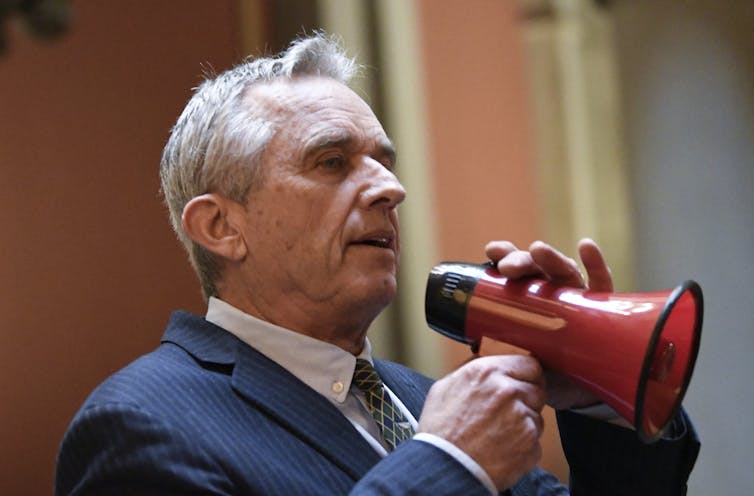President-elect Donald Trump’s controversial nomination of Robert F. Kennedy Jr. as United States health secretary presents new challenges for how media will report on health matters. Kennedy is an anti-vaccine activist and believes in various conspiracies about the COVID-19 pandemic. His nomination landed with a thud among health experts and the mainstream media.
This appointment, coupled with Trump’s frequent complaints about a liberal bias in the mainstream media that he claims exaggerate and distort the world around us, will make it difficult for media trying to maintain credibility when reporting health news. The pandemic provides a good place to draw some lessons.
Despite claims of the demise of mainstream media, there are still many people who refer to traditional news sources, particularly in uncertain times when accurate information is at a premium.

(AP Photo/Hans Pennink)
Based on a global study of the early stages of the pandemic, most people regardless of age ranked traditional media outlets (newspapers, television and radio) and the social media accounts belonging to these outlets as their primary sources of information during COVID-19.
Media in the pandemic
The pandemic resulted in an increase in demand for traditional media. In Canada, an April 2020 survey found that less than 10 per cent of respondents relied on social media as their main source of information; 51 per cent relied on local, national and international news outlets, and 30 per cent relied on daily briefings from public health agencies and political leaders. All major daily television news programs nearly doubled their year-to-date, average-minute audience.
Media coverage was indispensable during the pandemic for three reasons:
First, the media communicated important health and economic information to the public.
Second, the media highlighted the struggles of vulnerable communities affected by the pandemic when non-governmental organizations (NGOs) that typically addressed such issues were struggling themselves. Almost half of charities and NGOs received no support from permanent donors during the pandemic .
Finally, the media played an important role in supporting democratic accountability when government policymaking was frequent and spending was high but parliamentary and legislative checks were reduced. When comparing legislative sittings between 2018-19 and 2020-21, for example, provincial legislatures met anywhere from 5.5 per cent (Alberta) to 62.5 per cent (Nova Scotia) less often.
Despite these important roles, there were important limitations to how the media reported the uncertainty of the pandemic.
Lessons from COVID-19

THE CANADIAN PRESS/Darryl Dyck
Media is prone to exploiting cognitive biases. According to risk psychologists, people are typically more concerned about risks that are unknown and have high dread characteristics.
A pandemic has many of these characteristics, which made it fertile ground for sustained and, at times, sensationalized coverage, focusing on conflict and emotion, excluding probability data, oversimplifying complex matters, and vilifying those who went against the grain.
Here are some salient examples.
Despite the frequent claims to “follow the science” that featured so prominently in the media, U.S. research showed that coverage of the pandemic by American publications with a national audience tended to be more negative than the coverage by scientific journals, international publications and regional media.
In 2020, 87 per cent of COVID-19 coverage in U.S. media was deemed negative, emphasizing bad news and amplifying conflict and disagreement over government policies, regardless of whether different voices represented a small minority or a sizeable amount of the population.
Psychologists refer to identifiable-victim effect, when people focus on individuals and consequences and omit probability data. COVID-19’s serious toll in long-term care (LTC) homes, and the poor conditions found in some of those homes, was widely covered in 2020. However, even among those with loved ones in long-term care, over 78 per cent commented that they were satisfied with the service of the LTC facility — a fact that was virtually unobtainable if one depended solely on popular media for information.
During the third wave of the pandemic, the media ran stories about Canadian children becoming seriously ill even though youth made up only two per cent of hospitalizations. While it is true that stories about sick kids are newsworthy, they can also be sensationalist and exploitative.
After more than a year of COVID-19 stories and high death counts, at times it was difficult to distinguish between lower-probability and higher-probability cases, which is a fundamental characteristic of any risk problem.
The media also tended to vilify young people when they broke public health orders and gathering limits. Despite being at low risk of severe illness throughout the pandemic, young people paid a very heavy price for governments’ responses.
One study found that younger adults had to implement more behavioural changes than older individuals to comply with COVID-19 restrictions. The political priorities of young people — housing, social justice, environment and affordability — received much less attention from the media during the pandemic.
RFK Jr.’s nomination

(AP Photo/Ted S. Warren)
The role of the health secretary is partly an advisory role. RFK Jr. would influence as much as lead. Still, his appointment would be consequential.
Dr. Georges Benjamin, executive director at the American Public Health Association, said of Kennedy’s nomination: “More people will get sick, and I’m really concerned more people will die.”
Decentralized technology is changing the way we consume media. Despite Trump’s use of unconventional media strategies during the election campaign, it’s clear that the mainstream media play a disproportionately important role in how we consume information. Part of the challenge lies in how news sources maintain trustworthiness among their audiences. Trustworthiness depends on being transparent, knowledgeable and concerned.
Mainstream media will now have to develop new standards for transparency, particularly on how it uses and communicates scientific data. Media need to ensure that emotive stories that animate coverage are informed by appropriate probability and consequence data.
This will help ensure that the audience knows whether the cases in media are shown as exceptions to the norm, or pervasive. More transparent use of probability data will help ensure this.
